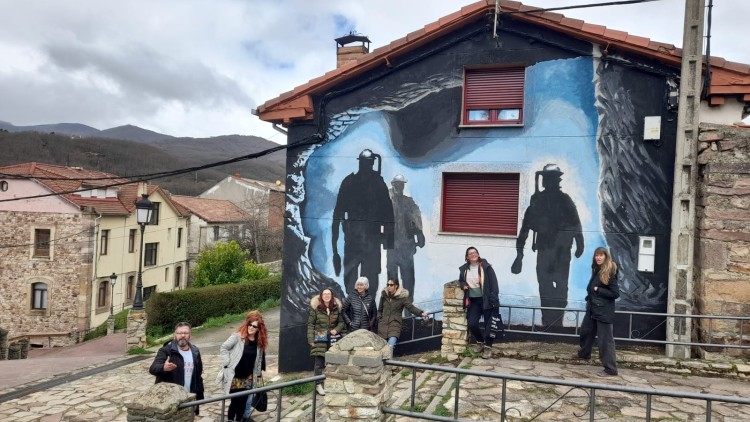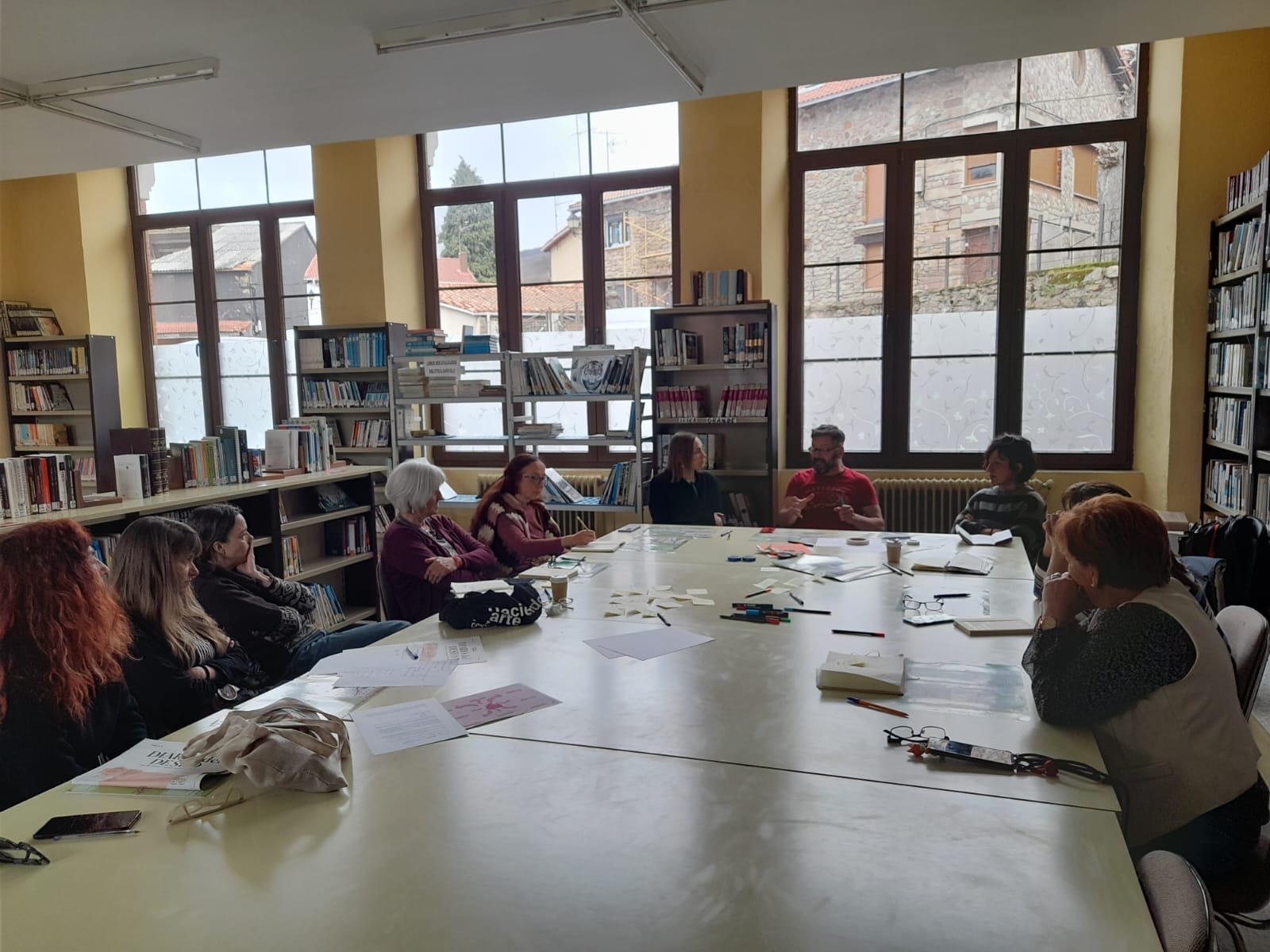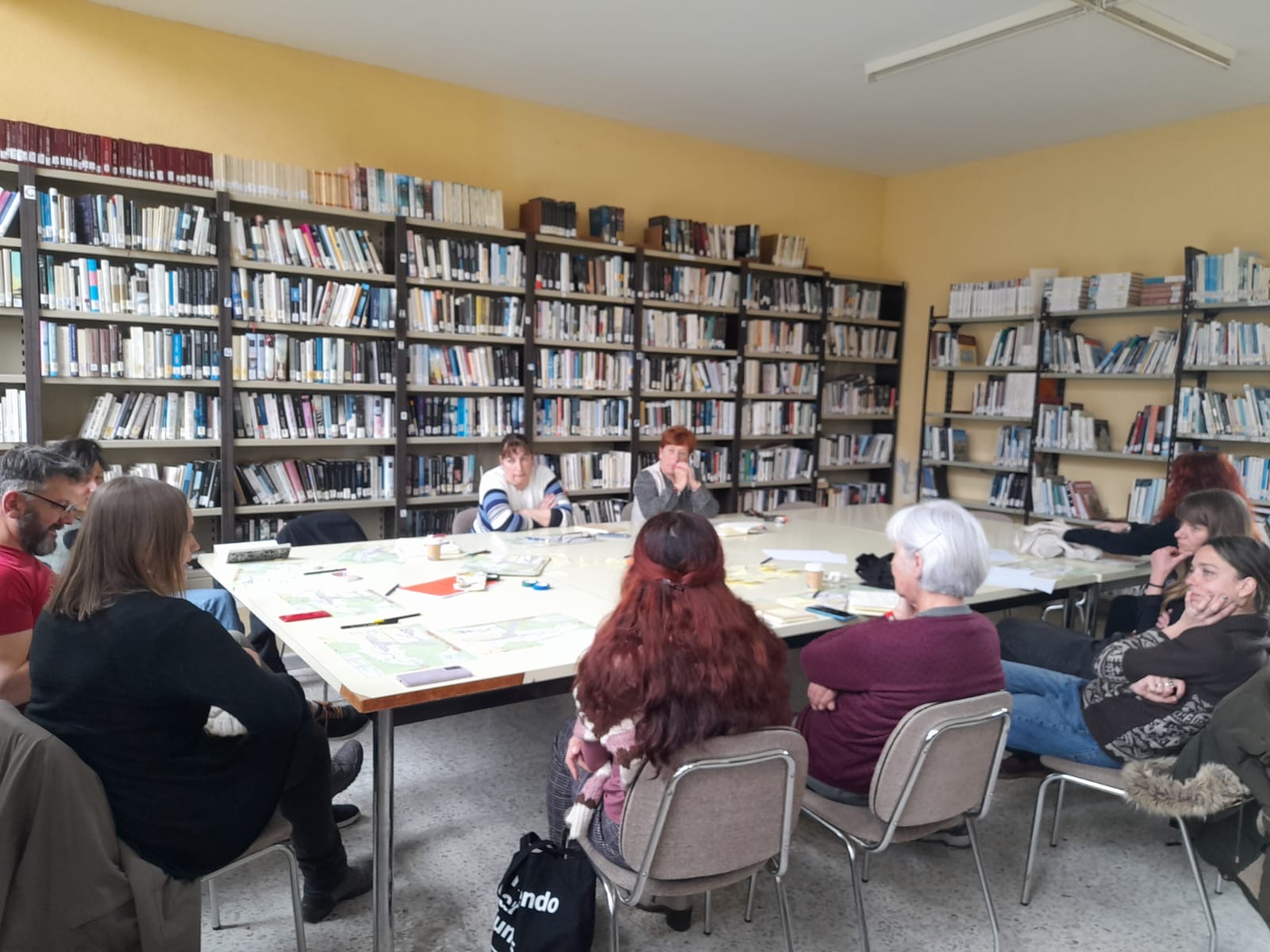Schlamm. The women's stories were swallowed up by the rubble of the mine.

The comissioners work on the word “aftermath” and explore their desires in depth.
Aquí puedes leer el texto en español / Here you can read the text in spanish
On this occasion, we meet at the library in Barruelo de Santullán. Mila, one of the participants, is the village librarian, and the library is a space she has created with great care. The place has many books and a large table on one side. This is where we will work today. Little by little, the participants arrive, and we greet each other. Outside, it is still very cold, as it was on the previous day.
Today, as on the previous day, the definitions of a word are the pivot around which the start of the day will revolve. On this occasion, we delve into the word “aftermath”. As we discuss, a two-sided conception of the world begins to emerge, and we sense that this may accompany the work process. The comissioners say that aftermath can be objective or subjective, physical or psychological, emotional or material, visible or invisible, and, due to the polysemy of the word “aftermath-sequel” in Spanish, there can be “sequels” and “prequels”.
These two sides are like those of the god Janus: the god of beginnings, doors, thresholds (here again we see that recurring image of the first day) and endings. Janus is depicted with two faces. One looks back and the other looks forward, observing past events and looking towards the future. This image is important because it is this project in which we are still on the threshold, with the desire to delve deeper and glimpse what the future holds. Furthermore, in our dialogues we have already talked about shared responsibility, and to achieve this we must look both to the past and to the future. To the legacies.

We continued working and wrote down our wishes on a map of concepts on the table: for me, for you, for us, and for the territory. After reading everyone's wishes, we began to play. We change their location on that map, so that our own desires became collective or territorial, and the desires for the person next to me became the desires that someone else had for me.
Reappropriating the individual desires of others as collective desires and vice versa can be a good exercise for understanding the community and understanding ourselves within it.
We continue talking about this community. From the comissioners, and one that we imagine to help us conclude this process, in addition to another that preceded the comissioners: that of the women who lived in this village. Women who fought in a hostile territory, where the myth of the male miner continues to be what sustains the territory to this day. Women who, despite being widowed with many children, did not succumb and raised their families. Widows who died collecting waste from the mine to keep warm, because no one brought them the heat from inside the earth anymore.
After this working session, it is increasingly clear to us that the issue that concerns us has very little to do with the heroics of the mining regions and much to do with the silenced stories. As Geles, a commissioner, says, with the legacy that women have left in the region.
Schlamm. Las historias de las mujeres se la tragó el escombro de la mina.
Las comitentes trabajan sobre la palabra “secuela” y profundizan sobre sus deseos.
En esta ocasión nos reunimos en la biblioteca de Barruelo de Santullán. Mila, una de las comitentes, es la bibliotecaria del pueblo y la biblioteca es un espacio que ella ha creado con mucho cariño. El lugar tiene muchos libros y una gran mesa en un lateral. Es aquí donde hoy trabajaremos. Poco a poco van llegando las comitentes y nos vamos saludando. En el exterior sigue haciendo mucho frío, como en la anterior jornada.
Hoy, al igual que en la anterior jornada, las definiciones de una palabra son el pivote sobre la que girará el inicio del día. En esta ocasión profundizamos en la palabra “secuela”. Mientras debatimos se empieza a vislumbrar la concepción del mundo en dos caras, y se intuye que esto puede acompañar el proceso de trabajo. Las comitentes dicen que las secuelas pueden ser objetivas o subjetivas, físicas o psicológicas, sentimentales o materiales, visibles o invisibles y, debido a la polisemia de la palabra “secuela” en castellano, pueden existir secuelas y precuelas.
Estas dos caras son como las del dios Jano: el dios de los comienzos, las puertas, los umbrales (aquí vuelve a aparecer esa imagen recurrente del primer día) y los finales. Jano es representado con dos caras. Una mira hacia atrás y otra hacia delante, observando los acontecimientos pasados y mirando hacia el futuro. Esta imagen es importante ya que es este proyecto en el que aún estamos en el umbral, con el deseo de profundizar y vislumbrar que nos deparará lo que venga. Además, en nuestros diálogos se ha hablado ya de corresponsabilidad, y para ello debemos mirar tanto hacia el pasado como hacia el futuro. Hacia los legados.
Seguimos trabajando y escribimos sobre la mesa, en un mapa de conceptos, los deseos que tenemos: para mí, para ti, para nosotras y para el territorio. Y después de leer los de todas, comenzamos a jugar. A cambiarlos de localización en ese mapa, de esta manera los deseos propios se transforman en colectivos o territoriales, y los deseos para la persona que tengo junto a mí pasan a convertirse en deseos que otra persona tiene para mí.
Reapropiarse de los deseos individuales de las demás como colectivos y viceversa puede ser un buen ejercicio para comprender la comunidad y comprendernos a nosotras mismas dentro de ella.
Continuamos hablando de esta comunidad. De la de comitentes, y de una que imaginamos para que nos ayude a concluir este proceso, además de otra que ha precedido a las comitentes: la de las mujeres que vivieron en este pueblo. Mujeres que lucharon en un territorio hostil, donde el mito del minero hombre sigue siendo aún hoy en día lo que sostiene el territorio. Mujeres que, a pesar de enviudar con muchos hijos, no sucumbieron y sacaron a su familia adelante. Viudas que murieron recogiendo los desechos de la mina para poder calentarse, porque ya nadie les traía el calor del interior de la tierra.
Tras esta sesión de trabajo, tenemos cada vez más claro que el tema que nos ocupa y nos preocupa tiene muy poco que ver con las heroicidades de las cuencas mineras, y mucho que ver con las historias silenciadas. Como dice Geles, una comitente, con las secuelas que las mujeres han dejado en el territorio.

